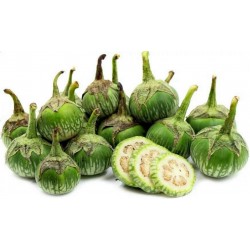Menu
-
MenuWstecz
- Home
-
Kategorie
-
-
Kategorie
-
Nasiona warzyw
-
Odmiany według kraju
- Odmiany z Armenii
- Odmiany z BiH
- Odmiany z Chorwacji
- Odmiany z Francji
- Varieties from Germany
- Varieties from Greece
- Varieties from Hungary
- Odmiany z Indii
- Varieties from Italy
- Odmiany z Japonii
- Odmiany z North Macedonii
- Varieties from Peru
- Varieties from Russia
- Varieties from Serbia
- Odmiany ze Słowenii
- Varieties from Spain
- Varieties from Thailand
- Odmiany z Turcji
- Varieties from USA
- Nasiona Pomidorów
- Nasiona kukurydzy
- Gurda rodziny
- Rodzina fasoli
- Nasiona Ogórka
- Nasiona Papryki
- Rodzina marchwi
- Rodzina cebuli
- Nasiona Sałaty
- Rodzina ziemniaków
- Rodzina kapuściana
- Nasiona Rzodkiewki
- Rodzina buraków
- Nasiona arbuza
- Nasiona melona
- Nasiona kalafiora
- Rodzina słoneczników
-
Odmiany według kraju
- Nasiona Owoców
- Nasiona Papryki Chili
- Nasiona ziół leczniczych
- Nasiona roślin pnących
- Drzewa - Krzewy - Nasiona
- Nasiona palmy
- Nasiona Traw Ozdobnych
- Nasiona tytoniu
-
Nasiona warzyw
-
-
-
-
- NOWE PRODUKTY
- Dostawa - płatność
- Utwórz konto
- FAQ
Lista produktów marki Seeds Gallery
Seeds produced by Seeds Gallery
Seeds produced by Seeds Gallery
Jest 408 produktów.
Pokazano 361-372 z 408 pozycji

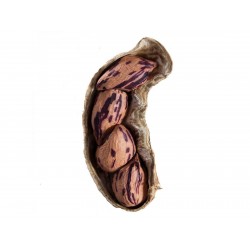
Tiger Peanut Seeds (Arachis...
Cena
2,25 €
SKU: P 136 T
Seeds Gallery Com,
5/
5
<h2><strong>Tiger Peanut Seeds (Arachis Hypogaea)</strong></h2>
<h2><span style="color:#ff0000;"><strong>Price for Package of 5 seeds.</strong></span></h2>
<p>110 days.One of the varieties grown during the 1800s was the African peanut (also known as the N. Carolina peanut). It may have been a black peanut, possibly the same as ‘Carolina Black.’ According to food historian William Woys Weaver, the black peanut may have been used as a substitute for Black Bambarra (African ground nut) by the black community. Black Bambarra is important in African folk medicine as an aphrodisiac. The N. Carolina climate won’t support black Bambarra, but black pea- nuts grow there without difficulty. Carolina Black produces sweet-tasting, black-skinned peanuts that are slightly larger than Spanish peanuts.</p>
<p>The peanut, or groundnut (Arachis hypogaea), is a species in the legume or "bean" family (Fabaceae). The peanut was probably first domesticated and cultivated in the valleys of Paraguay.[1] It is an annual herbaceous plant growing 30 to 50 cm (1.0 to 1.6 ft) tall. The leaves are opposite, pinnate with four leaflets (two opposite pairs; no terminal leaflet), each leaflet is 1 to 7 cm (⅜ to 2¾ in) long and 1 to 3 cm (⅜ to 1 inch) broad.</p>
<p>The flowers are a typical pea flower in shape, 2 to 4 cm (0.8 to 1.6 in) (¾ to 1½ in) across, yellow with reddish veining. Hypogaea means "under the earth"; after pollination, the flower stalk elongates causing it to bend until the ovary touches the ground. Continued stalk growth then pushes the ovary underground where the mature fruit develops into a legume pod, the peanut – a classical example of geocarpy. Pods are 3 to 7 cm (1.2 to 2.8 in) long, containing 1 to 4 seeds.[2]</p>
<p>Peanuts are known by many other local names such as earthnuts, ground nuts, goober peas, monkey nuts, pygmy nuts and pig nuts.[3] Despite its name and appearance, the peanut is not a nut, but rather a legume.</p>
<h3><strong>Cultivation</strong></h3>
<p>The orange-veined, yellow-petaled, pea-like flower of the Arachis hypogaea is borne in axillary clusters above ground. Following self-pollination, the flowers fade and wither. The stalk at the base of the ovary, called the pedicel, elongates rapidly, and turns downward to bury the fruits several inches in the ground, where they complete their development. The entire plant, including most of the roots, is removed from the soil during harvesting.[8] The fruits have wrinkled shells that are constricted between pairs of the one to four (usually two) seeds per pod.</p>
<p>Peanuts grow best in light, sandy loam soil. They require five months of warm weather, and an annual rainfall of 500 to 1,000 mm (20 to 39 in) or the equivalent in irrigation water.[9]</p>
<p>The pods ripen 120 to 150 days after the seeds are planted. If the crop is harvested too early, the pods will be unripe. If they are harvested late, the pods will snap off at the stalk, and will remain in the soil.[8] They need an acidic soil to grow preferably with 5.9-7 pH.</p>
<p>Peanuts are particularly susceptible to contamination during growth and storage. Poor storage of peanuts can lead to an infection by the mold fungus Aspergillus flavus, releasing the toxic and highly carcinogenic substance aflatoxin. The aflatoxin-producing molds exist throughout the peanut growing areas and may produce aflatoxin in peanuts when conditions are favorable to fungal growth.</p>
<p>Harvesting occurs in two stages[citation needed]: In mechanized systems, a machine is used to cut off the main root of the peanut plant by cutting through the soil just below the level of the peanut pods. The machine lifts the "bush" from the ground and shakes it, then inverts the bush, leaving the plant upside down on the ground to keep the peanuts out of the soil. This allows the peanuts to dry slowly to a bit less than a third of their original moisture level over a period of three to four days. Traditionally, peanuts were pulled and inverted by hand.</p>
<p>After the peanuts have dried sufficiently, they are threshed, removing the peanut pods from the rest of the bush.</p>
<h3><strong>Uses</strong></h3>
<p>Peanuts have many uses. They can be eaten raw, used in recipes, made into solvents and oils, medicines, textile materials, and peanut butter, as well as many other uses. Popular confections made from peanuts include salted peanuts, peanut butter (sandwiches, peanut candy bars, peanut butter cookies, and cups), peanut brittle, and shelled nuts (plain/roasted). Salted peanuts are usually roasted in oil and packed in retail-size plastic bags or hermetically sealed cans. Dry roasted salted peanuts are also marketed in significant quantities. Peanuts are often a major ingredient in mixed nuts because of their relative cost compared to Brazil nuts, cashews, walnuts, and so on. Although peanut butter has been a tradition on camping trips and the like because of its high protein content and because it resists spoiling for long periods of time, the primary use of peanut butter is in the home. Large quantities are also used in the commercial manufacture of sandwiches, candy, and bakery products. Boiled peanuts are a preparation of raw, unshelled green peanuts boiled in brine and often eaten as a snack. More recently, fried peanut recipes have emerged – allowing both shell and nut to be eaten. Peanuts are also used in a wide variety of other areas, such as cosmetics, nitroglycerin, plastics, dyes and paints.</p>
<h3><strong>Peanut oil</strong></h3>
<p>Peanut oil is often used in cooking because it has a mild flavor and a relatively high smoke point. Due to its high monounsaturated content, it is considered more healthy than saturated oils and is resistant to rancidity. There are several types of peanut oil including aromatic roasted peanut oil, refined peanut oil, extra virgin or cold-pressed peanut oil and peanut extract. In the United States, refined peanut oil is exempt from allergen labeling laws.</p>
<h3><strong>Peanut flour</strong></h3>
<p>Peanut flour is lower in fat than peanut butter and is popular with chefs because its high protein content makes it suitable as a flavor enhancer[citation needed]. Peanut flour is used as a gluten-free solution.</p>
<h3><strong>Boiled peanuts</strong></h3>
<p>Boiled peanuts are a popular snack in the southern United States, as well as in India, China and West Africa.</p>
<h3><strong>Dry roasted peanuts</strong></h3>
<p>Dry peanuts can be roasted in the shell in a home oven if spread out one layer deep in a pan and baked at a temperature of 350°F or 177°C for 18–20 minutes.</p>
<h3><strong>Cuisine</strong></h3>
<h3><strong>South America</strong></h3>
<p>Peanuts are used in many sauces for South American meat dishes, especially rabbit. Peanuts are common in Peruvian cuisine, which marries native and European ingredients. For instance, roasted peanuts and hot peppers, both native to South America, appear with roasted onions, garlic, and oil—all of European origin—in a smooth sauce poured over boiled potatoes, a dish well known in the city Arequipa and called papas con ocopa. Another example is a fricassee combining a similar mixture with sautéed seafood or boiled and shredded chicken. These dishes are generally known as ajíes, meaning "hot peppers", such as ají de pollo and ají de mariscos. (Seafood ajíes may omit peanuts.)</p>
<p>Likewise, during Colonial times, the Spanish in Peru used peanuts to replace nuts unavailable in Peru but used extensively in Spanish cuisine, such as almonds, pine nuts, and other nuts, typically ground or as paste and mixed with rice, meats, and vegetables for dishes such as rice pilaf.</p>
<h3><strong>Southwest Asia</strong></h3>
<p>Crunchy coated peanuts, called kabukim in Hebrew, are a popular snack in Israel. Kabukim are commonly sold by weight at corner stores where fresh nuts and seeds are sold, though they are also available packaged. The coating typically consists of flour, salt, starch, lecithin, and sometimes sesame seeds. The origin of the name is obscure.(It may be derived from kabuk which means nutshell or husk in Turkish.) An additional variety of crunchy coated peanuts popular in Israel is "American peanuts". The coating of this variety is thinner, but harder to crack.</p>
<p>Another popular Israeli peanut snack, Bamba puffs, is similar in shape to Cheez Doodles, but are made of corn and flavored with peanut butter.</p>
<h3><strong>Southeast Asia</strong></h3>
<p>Peanuts are also widely used in Southeast Asian cuisine, particularly Indonesia, where they are typically made into a spicy sauce. Peanuts originally came to Indonesia from the Philippines, where the legume came from Mexico in times of Spanish colonization.</p>
<p>Common Indonesian peanut-based dishes include gado-gado, pecel, karedok and ketoprak, all vegetable salads mixed with peanut sauce, and the peanut-based sauce for satay.</p>
<p>In the Indian subcontinent, peanuts are known as a light snack by themselves, usually roasted and salted (sometimes with the addition of chilli powder), and often sold roasted in pod, or boiled with salt. They are also made into little dessert or sweet snack pieces by processing with refined sugar and jaggery. Indian cuisine uses roasted, crushed peanuts to give a crunchy body to salads; they are added whole (without pods) to leafy vegetable stews for the same reason. Another use of peanut oil as cooking oil. Most Indians use mustard, sunflower, and peanut oil for cooking. Peanuts are not native to India. They are thought to have come to India from Philippines. Notably, the name of this nut in northern parts of Tamil Nadu is 'மணிலாக் கொட்டை'- slang மல்லாக் கொட்டை- (Manila-k-kottai) means nut from Manila, the capital city of Philippines.</p>
<h3><strong>West Africa</strong></h3>
<p>Peanuts grow well in southern Mali and adjacent regions of the Ivory Coast, Burkina Faso, Ghana, Nigeria and Senegal; peanuts are similar in both agricultural and culinary qualities to the Bambara groundnut native to the region, and West Africans have adopted the crop as a staple. Peanut sauce, prepared with onions, garlic, peanut butter/paste, and vegetables such as carrots, cabbage, and cauliflower, can be vegetarian (the peanuts supplying ample protein) or prepared with meat, usually chicken.</p>
<p>Peanuts are used in the Mali meat stew maafe. In Ghana, peanut butter is used for peanut butter soup nkate nkwan.[13] Crushed peanuts may also be used for peanut candies nkate cake and kuli-kuli, as well as other local foods such as oto.[13] Peanut butter is also an ingredient in Nigeria's "African salad".</p>
<p>Peanut powder is an important ingredient in the spicy coating for kebabs in Nigeria and Ghana.</p>
<h3><strong>East Africa</strong></h3>
<p>Peanuts are a common ingredient of several types of relishes (dishes which accompany nshima) eaten by the tribes in Malawi and in the eastern part of Zambia, and these dishes are now common throughout both countries. Thick peanut butter sauces are also made in Uganda to go with rice and other starchy foods. Across East Africa, roasted peanuts (often in cones of newspaper) are a popular snack sold in the street.</p>
<h3><strong>North America</strong></h3>
<p>In the US, peanuts are used in candies, cakes, cookies, and other sweets. They are also enjoyed roasted and salted. Peanut butter is one of the most popular peanut-based foods in the US, and for four hundred years, recipes for peanut soup have been present in the South, Virginia in particular. In some southern portions of the US, peanuts are boiled for several hours until soft and moist. Peanuts are also deep-fried, shell and all.</p>
<h3><strong>Malnutrition</strong></h3>
<p>Peanuts are used to help fight malnutrition. Plumpy Nut, MANA Nutrition,[14] and Medika Mamba[15] are high-protein, high-energy and high-nutrient peanut-based pastes developed to be used as a therapeutic food to aid in famine relief. The World Health Organization, UNICEF, Project Peanut Butter and Doctors Without Borders have used these products to help save malnourished children in developing countries.</p>
<h3><strong>Other uses</strong></h3>
<p>Peanuts can be used like other legumes and grains to make a lactose-free milk-like beverage, peanut milk. Peanut plant tops are used for hay.</p>
<p>Low-grade or culled peanuts not suitable for the edible market are used in the production of peanut oil for manufacturing.[citation needed] The protein cake (oilcake meal) residue from oil processing is used as an animal feed and as a soil fertilizer. Low-grade peanuts are also widely sold as a garden birds feed.</p>
<p>Peanuts have a variety of industrial end uses. Paint, varnish, lubricating oil, leather dressings, furniture polish, insecticides, and nitroglycerin are made from peanut oil. Soap is made from saponified oil, and many cosmetics contain peanut oil and its derivatives. The protein portion is used in the manufacture of some textile fibers. Peanut shells are used in the manufacture of plastic, wallboard, abrasives, fuel, cellulose (used in rayon and paper) and mucilage (glue). Rudolf Diesel ran some of the first engines that bear his name on peanut oil[16] and it is still seen as a potentially useful fuel.</p>
<p>Plant Common Name: Peanut seeds</p>
<p>Plant Genus/Species Name: Arachis hypogaea</p>
<p>Sowing Temperature: 16 - 26 Celcius</p>
<p>Growing Temperature: 8 - 38 Celcius</p>
<p>Days to Maturity: 60-80 Days</p>
<h2><span style="color:#008000;"><strong>How to Sow Peanut</strong></span></h2>
<p>Peanuts need a long, hot growing season to fully mature. Do not plant in areas that do not have at least 4-5 months of frost-free weather. Shell the seeds before sowing. In loose, well-drained soil in a sunny location, sow seeds directly outdoors after the last frost. Plant in light deeply dug and prepared alkaline soil. Create a furrow 2" deep and sow seeds 4-6" apart, being careful not to damage the tender seeds. Space rows 3' apart. Seeds germinate in 10-15 days.</p>
P 136 T (5 S)


Büyük Britanya'dan Çeşitli
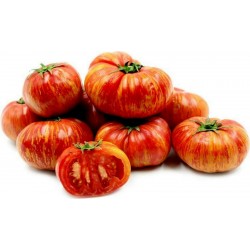
Tigerella Tomato seeds
Cena
1,85 €
SKU: VT 19
Seeds Gallery Com,
5/
5
<h2><strong>Tigerella Tomato seeds</strong></h2>
<h2><span style="color: #ff0000;"><strong>Price for Package of 10 seeds.</strong></span></h2>
<p>Tigerella is a bi-colored tomato cultivar, relatively small, 2 to 4 ounces (60-120 g), and early (59 days). Upon maturity, the fruit is red with yellow stripes, essentially the same as Green Zebra, except that the fruit is red instead of green, and has a sweeter flavor.</p>
<p>Tigerella heirloom tomatoes were developed in the 1950s by Dr. Lewis Darby of Great Britain, maybe. Other sources state that Tigerella tomato seeds were bred by the Glasshouse Research Institute in England in the 1930s as a cross between an unknown cultivar and Ailsa Craig.</p>
<p>A stunning Heirloom standard-sized round variety with red-orange skin and golden-green to yellow jagged stripes. It crops reliably and heavily up to 3 Weeks earlier than Moneymaker and grows well outdoors or in a greenhouse in all areas with a rich, tangy flavor. Cordon (Indeterminate).</p>
<p><span style="font-family: verdana, geneva, sans-serif;"><strong>What's the difference between "indeterminate" and "determinate" tomatoes?</strong></span></p>
<p><span style="font-family: verdana, geneva, sans-serif;"><strong>Determinate tomatoes</strong>, or "bush" tomatoes, are varieties that grow to a compact height (generally 3 - 4'). Determinates stop growing when fruit sets on the top bud. All the tomatoes from the plant ripen at approximately the same time (usually over a period of 1- 2 weeks). They require a limited amount of staking for support and are perfectly suited for container planting.</span></p>
<p><span style="font-family: verdana, geneva, sans-serif;"><strong>Indeterminate tomatoes</strong> will grow and produce fruit until killed by frost. They can reach heights of up to 12 feet although 6 feet is normal. Indeterminates will bloom, set new fruit and ripen fruit all at the same time throughout the season. They require substantial staking for support and benefit from being constrained to a central growing stem.</span></p><script src="//cdn.public.n1ed.com/G3OMDFLT/widgets.js"></script>
VT 19 (10 S)


Meksika'dan Çeşitli
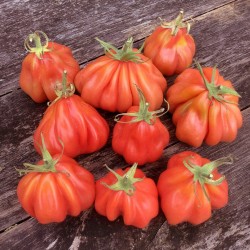
Tlacolula Ribbed Heirloom...
Cena
1,95 €
SKU: VT 40
Seeds Gallery Com,
5/
5
<h2><strong>Tlacolula Ribbed Heirloom tomato Seeds</strong></h2>
<h2><span style="color:#ff0000;"><strong>Price for Package of 10 seeds.</strong></span></h2>
<p>Tlacolula de Matamoros is likely where the name of this tomato came from and is a city situated in the state of Oaxaca. Tlacolula, as one might expect, is a Nauhatl word. The exact translation doesn’t seem to be too clear, but it is usually attributed to meaning “place of many sticks” or “twisted thing”. The latter could very well apply to this tomato.</p>
<p>While this tomato isn’t literally twisted, it is of a characteristic heavily ribbed/pleated shape that quite a few tomatoes possess that come from in and around this region of Mexico. When I see a heavily pleated tomato, I must have it. I’m a sucker for the pleats. And when I learn a tomato is traced back to these areas of Central America? That’s the clincher.</p>
<p><strong>The Look</strong></p>
<p>As previously mentioned, this is one of those lovely awe-inspiring heavily pleated/ruffled tomatoes. My mom characterizes these as “looking like peppers”. This one reminded me quite a bit of ‘Zapotec Pink Pleated’, except it was more red then pink. The fruit was smaller than the Zapotec tomato as well, getting about 3-4″ in diameter and weighing in at about 8-10oz each (as opposed to Zapotec’s 4-6″ in diameter and 1-1.5lb weights). They are another hollow tomato, but once again, not quite as hollow I found as Zapotec Pink Pleated.</p>
<p><strong>The Taste</strong></p>
<p>This is a good fresh eating tomato. Despite its red flavour, it’s low in acidity, so it’s good for people with stomach problems who don’t want to limit themselves to whites, yellows, and orange tomatoes. It’s great for stuffing and then baking, although because of it’s mild flavour after it’s baked you don’t get a ton of tomatoeyness to go with whatever you’re cooking.</p>
<p>Slightly hollow, firm flesh with moderate juice. Good taste!</p>
VT 40 (10 S)


Odmiana z Ameryki
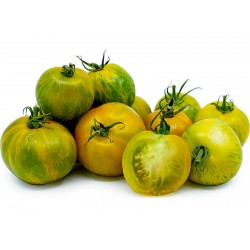
Tomato Green Zebra Seeds
Cena
1,95 €
SKU: VT 18
Seeds Gallery Com,
5/
5
<!DOCTYPE html>
<html>
<head>
<meta http-equiv="Content-Type" content="text/html; charset=UTF-8" />
</head>
<body>
<h2><strong>Tomato Green Zebra Finest Seeds</strong></h2>
<h2><span style="color: #ff0000;"><strong>Price for Package of 10 seeds.</strong></span></h2>
<p>Green Zebra tomatoes are covered in vertical stripes that line the exterior of their vibrant green skin. When ripe the stripes will turn from pale green to yellow. Tomato the Green Zebra grows to approximately 5 cm (2 inches) in diameter and has a round, globe-like shape. Resistant to cracking the skin of the Green Zebra is uniformly smooth and covers a green fleshed, juicy interior. Its flesh has a classic tomato flavor and will be tangy and astringent when young then take on a balanced sweet-tart flavor once fully ripe.</p>
<p>The Green Zebra tomato can be utilized raw or cooked in a plethora of recipes where traditional tomatoes are used. Their petite size makes them ideal for use quartered and added to salads, skewered on kebabs or hollowed out and stuffed. When young their sturdy texture and tart flavor is perfect for use in cooked applications. Cooking will mellow the acidity of young green tomatoes. They can be sautéed, slow-roasted or breaded and fried. The meat of the Green Zebra is hearty and will not break down when cooked. Green tomatoes such as the Green Zebra will also work well when pickled, smoked or cooked down to make preserves. Their flavor is complemented by balsamic, olive oil, cornmeal, oregano, basil, peppercorn, red onion, fennel, avocado, jalapeno, garlic, grilled beef, mozzarella and cream-based sauces. For best flavor keep Green Zebra tomatoes at room temperature, once sliced they will keep in the refrigerator for up to 2 days.</p>
<p>The Green Zebra tomato could also be called "The Green Bay Packers" tomato as it is often rumored to be colored for Wisconsin's NFL team with its green and gold stripes.</p>
<p>The Green Zebra tomato was first developed in Everett, Washington in 1983 by Tom Wagner. As a plant breeder, Wagner had long been intrigued by the evergreen tomato. He set out to develop a striped green variety that unlike most green tomatoes would be resistant to cracking. To achieve this new tomato variety Wagner crossed 4 heirloom varieties, one of which was the Evergreen tomato. He named the tomato Green Zebra, a nod to the tomatoes' unique striping. It was featured in Wagner's Tater-Mater Seed Catalog 1993 through 1996 during which time it achieved commercial success in both the gardening and culinary world. Today they are grown and distributed predominately out of Mexico and California.</p>
</body>
</html>
VT 18 (10 S)


Sırbistan'dan Çeşitli
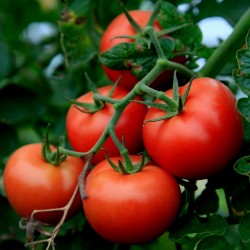
Tomato Novosadski Jabucar...
Cena
2,15 €
SKU: VT 130
Seeds Gallery Com,
5/
5
<h2 class=""><strong>Tomato Novosadski Jabucar 50 seeds</strong></h2>
<h2><span style="color: #ff0000;"><strong>Price for Package of 50 seeds.</strong><strong><br></strong></span></h2>
<div>70-80 days, Medium early variety, Indeterminate. The fruits are round, smooth, bright red, average weight is 130-150 g. He has a good ratio of total sugar and acid, with a dry matter content of 6 to 6.5% and a very good taste. It can be grown from seeds, and without support.</div>
<div>History:</div>
<div>Old tested variety from Serbia. 'Jabucar' means 'Apple' in Serbian.</div><script src="//cdn.public.n1ed.com/G3OMDFLT/widgets.js"></script>
VT 130 (50 S)


Almanya'dan Çeşitli
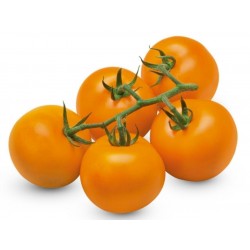
Tomato Seed AURIGA (Solanum...
Cena
1,85 €
SKU: VT 150
Seeds Gallery Com,
5/
5
<h2><strong><em><span style="text-decoration: underline;" class="">Tomato Seed AURIGA (Solanum lycopersicum)</span></em></strong></h2>
<h3><span style="color: #ff0000;"><strong>Price for Package of 10 seeds. </strong></span></h3>
<p>This is a lovely variety of tomato from east Germany, and is particularly well suited for outdoor growing - in fact, it is just as happy growing outside as it is under protection.</p>
<p>Fairly early to start ripening, the fruits are just a little smaller than a billiard ball in size. Thin-skinned, they are extremely sweet and juicy. If you let them mature on a little longer to 'very ripe' the flavor of the fruit changes to a gorgeous almost Melon taste - very distinctive!</p>
<p>Vigorous but compact inhabit this is a such a good variety in so many ways!</p>
<p>This is an indeterminate variety and best grown as a cordon (vine)</p>
<p>For best yields and size of fruit - stop at 5th truss if growing under protection (4th outside)</p>
<p>Suitable for growing both outsides and under protection.</p><script src="//cdn.public.n1ed.com/G3OMDFLT/widgets.js"></script>
VT 150 (10 S)


Sırbistan'dan Çeşitli
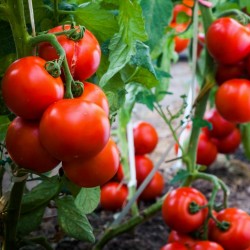
Tomato seeds Gruzanski Golden
Cena
1,65 €
SKU: VT 139
Seeds Gallery Com,
5/
5
<h2><strong>Tomato seeds Gruzanski Golden</strong></h2>
<h2><span style="color: #ff0000;"><strong>Price for Package of 20 seeds.</strong></span></h2>
<p>Gruzanski Golden tomato is an old variety from Serbia and one of the favorite tomato varieties in Serbia for fresh use. The plant is medium-lush, tall, well-leafed. The fruit is juicy, round to slightly elongated, medium firmness, average weight 170-190 grams, unripe fruit is whitish in color and intense ripe red and very tasty, excellent for fresh consumption and sauces. Ideal for pickling tomatoes when unripe.</p>
<p>Resistance: Verticillium albo-atrum, Fusarium oxysporum f. Sp. Lycopersici, Phytophthora infestans</p>
<p>Note: Medium early open field production with support.</p><script src="//cdn.public.n1ed.com/G3OMDFLT/widgets.js"></script>
VT 139 (20 S)

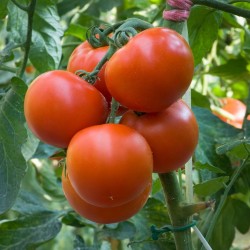
Tomato seeds Jasenički...
Cena
1,55 €
SKU: VT 46
Seeds Gallery Com,
5/
5
<h2 class=""><strong>Tomato seeds Jasenički Jabučar (Jasenica apple)</strong></h2>
<h2><span style="color: #ff0000;"><strong>Price for Package of 20 seeds.</strong></span></h2>
<p>Jasenički jabučar tomato is an old variety from Serbia and one of the favorite tomato varieties in Serbia for fresh use, salads, etc. It is similar to "Saint Pierre" but with a much better yield. The plant is lush, tall, well-leafed. The fruit is juicy, sweet with a little acid, round to slightly flat, average weight 150-170 grams, ripe fruit is red and very tasty, excellent for fresh consumption and sauces. Ideal for pickling tomatoes when unripe.</p>
<p>Can be sown from seedlings or by direct sowing in the field.</p>
<p>Resistant to: Verticillium albo-atrum, Fusarium oxysporum f. Sp. Lycopersici, Phytophthora infestans</p>
<p>Note: Medium early open field production with support.</p><script src="//cdn.public.n1ed.com/G3OMDFLT/widgets.js"></script>
VT 46 (20 S)


Rusya'dan Çeşitli
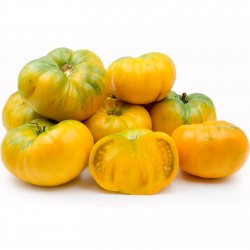
Tomato Seeds Persimmon Orange
Cena
1,85 €
SKU: VT 161
Seeds Gallery Com,
5/
5
<!DOCTYPE html>
<html>
<head>
<meta http-equiv="Content-Type" content="text/html; charset=UTF-8" />
</head>
<body>
<h2><span style="text-decoration: underline;"><em><strong>Tomato Seeds Persimmon Orange</strong></em></span></h2>
<h3><span style="color: #ff0000;"><strong>Price for Package of 10 seeds.</strong></span></h3>
<div>This plant produces good yields golden-orange tomatoes weighing from 1-2 lbs. This fruit has a mild sweet flavor, meaty in texture, and have relatively few seeds. This variety originated in Russia. Determinate. Plant reaches 3 ft in height. 80 days.</div>
</body>
</html>
VT 161

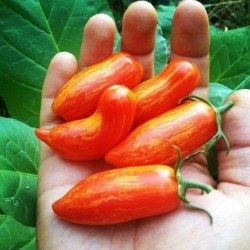
Tomato Seeds SWEET CASADAY
Cena
1,95 €
SKU: VT 63
Seeds Gallery Com,
5/
5
<!DOCTYPE html>
<html>
<head>
<meta http-equiv="Content-Type" content="text/html; charset=UTF-8" />
</head>
<body>
<h2><strong>Tomato Seeds SWEET CASADAY</strong></h2>
<h2><span style="color: #ff0000;"><strong>Price for Package of 5 seeds.</strong></span></h2>
<p>Sweet Casady is a small (5cm long and about 25g in weight) elongated plum tomato that is bright red with yellow/orange stripes. It very sweet and also beautiful (a rare combination) – A lovely plum/cherry tomato with a unique shape and look and incredibly productive and tasty! </p>
<p>Sweet Casaday is a great fresh eating tomato for home and market gardeners in the style of the Artisan-tomatoes. It has beautiful elongated red plum tomatoes with yellow stripes.<br />The attractive fruits are about 5 cm long, sweet with excellent full tomato flavour. They are ideal for fresh eating. ‘Sweet Casaday’ is very suitable for canning as well and makes also an excellent tomato paste. It is an indeterminate variety. Its beautiful appearance makes it a perfect variety for home gardeners. It is very versatile and can be grown successfully on patios and big balconies because it does well in large containers.<br /> Beautiful red fruits with yellow stripes.<br /> Excellent taste, sweet with rich tomato flavour.<br /> Very versatile in the kitchen and ideal for colourful mixes.<br /> Indeterminate, also recommendable for patio gardeners when it is grown in large containers.</p>
</body>
</html>
VT 63


Odmiana z Hiszpanii
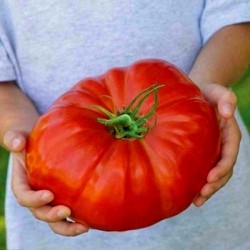
Tres Cantos Beefsteak...
Cena
1,95 €
SKU: VT 42
Seeds Gallery Com,
5/
5
<h2><strong>Tres Cantos tomato seeds</strong></h2>
<h2><span style="color:#ff0000;"><strong>Price for Package of 10 seeds.</strong></span></h2>
<p>The Tres Cantos tomato is an heirloom from Tenerife. The name translates ‘Three Songs’ from Spanish. Indeterminate, regular leaf plant produces large amounts of 500 g, round, juicy, red tomatoes with bold, slightly-acidic, tomatoey flavors. Perfect choice for salads, canning, and market.</p>
<p>The beefsteak tomatoes are juicy with few seeds. Their flavor is excellent, savory with a great balance of acidic and sweet. The plants are strong growing, prolific and will need tall canes for support. For best results in yield, remove side shoots and restrict the plant to one main stem. They are resistant to most tomato diseases.</p>
<ul><li><strong>Type</strong>: Tres Cantos Tomato</li>
<li><strong>Optimal germination temperature</strong>: 20 - 25 °C</li>
<li><strong>Sowing</strong>: February - April</li>
<li><strong>Germination period</strong>: 8 - 14 days</li>
<li><strong>Plant height</strong>: approx. 150-180 cm in height, stake tomato</li>
<li><strong>Fruit appearance</strong>: red, flat-round, 500 g, juicy beefsteak</li>
<li><strong>Taste</strong>: aromatic, sweet and juicy</li>
<li><strong>Harvest</strong>: from August to October</li>
<li><strong>Origin</strong>: Tenerife / Spain</li>
</ul>
VT 42 (10 S)


